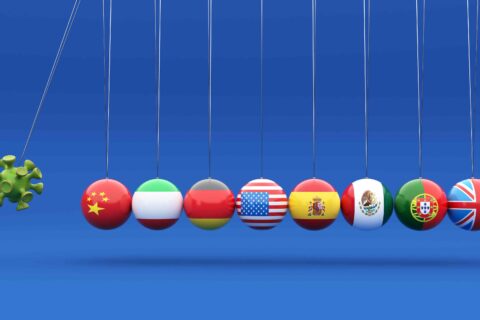How to weather the coming economic storm
ESOMAR’s Community Circles continued its topic on business developments with a focus on financial viability, how can you prepare your business for the economic storm that will follow the COVID-19 pandemic. The icebreakers for the session were Bart Jansen(ABN AMRO), Crispin Beale (CJ Bealoe), Simon Chadwick (Cambiar Consulting) and Jim Grien (TM Capital), who shared insights and their expertise of past crises on how to maintain a sustainable cash flow, and what tools to use to maintain that flow.
Broadly speaking three themes have been discussed:
- Short term impacts;
- Long term projections; and
- Approaches to financial difficulties
all of which come with their own approaches. However, at the same time it should be stressed that predicting the financial market at the moment is like throwing darts while blindfolded.
Short term impacts
There has been a massive write off of market capital, with some predicting a $5 trillion write-off from the global economy over the next two years – equal to the annual output of Japan. This will undoubtfully have an impact on every part of the economy. But while there was a lot of fear and lack of liquidity in early March, the markets seem to have since bounced back by 20-25%. This strongly suggests that for the moment there is enough cash available from venture capitalists and private equity, for example.
This can help you address the most immediate challenge: ensure you have a healthy cashflow. First and most of all, cash is king. Without a cashflow no business will survive. Your financial resilience is a key point to consider – assess how long you can keep your business going under the current circumstances.
Scenario planning is a very useful tool to assess your business: build a practical, worst case model, and do what you can to manage your business to sustain it through that model. Make sure when doing that, that you listen to your consumers and your clients – change starts with clients. When reviewing the outcomes try to invest practically in the short term and strategically in the long term.
Long term projections
In the long-term, we can see positive projections – interest rates remain very low (or even negative) and there is the expectation that the support kits will have a positive impact. Also, the governmental stimulus packages have a positive impact. These will ensure businesses can bounce back after the crisis and the economy can recover quicker. However, whilst there is positive news, there is still a lot of uncertainty – there will be enormous opportunity, but you have to sustain your organisation.
During every crisis changes in human behaviour will shape the future of business. Take this chance to redefine how you work with colleagues and clients and review the sector you operate in. If you see a long term or permanent decline in this sector, now is the time to pivot and explore new opportunities.
Approaches to financial difficulties
Even with sufficient planning, preparation and government stimulus programmes you may get into financial difficulties. Talk with your clients and lending partners about this. People are understanding of the fact that we are all going through a crisis together. They all want to be cooperative and have every incentive to work with you. Be proactive and they are likely willing to help in these unusual times.
The governmental programmes can also be an important tool. Explore these survival kits but ensure you understand how these support plans can help you. If you don’t need them right away, you might apply for them at a later stage.
Lead by example. For example, look at cutting C-suite pay and bonuses – showing a willingness to make sacrifices shows your employees that you care about your organization.
No matter how dire the current situation may look right now, this crisis will be over, sooner or later. Make sure you plan for the future. Look at the opportunities to catch-up on housekeeping and best practice that you may not get a chance to do when you are busy.


